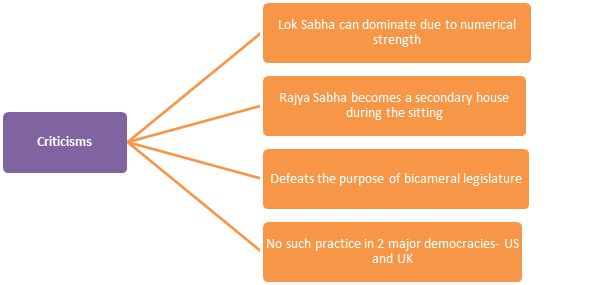About:
-
- Article 108 of the Indian Constitution that provides for joint sitting to resolve deadlocks.
- Three situations after a bill has been passed by one House and transmitted to the other House if:
- Bill rejected by the other House
- Disagreement on the amendments to be made
- More than six months have elapsed without the bill being passed
- President can summon both the Houses to meet in a joint sitting
- Applicable to ordinary bills or financial bills only and not to money bills or Constitutional amendment bills
- 3 bills have been passed at joint sittings:
- Dowry Prohibition Bill, 1960
- Banking Service Commission (Repeal) Bill, 1977
- Prevention of Terrorism Bill, 2002
Process
-
- Speaker of Lok Sabha presides over a joint sitting of the two Houses and the Deputy Speaker, in his absence.
- Quorum- one-tenth of the total number of members of the two Houses.
- Governed by the Rules of Procedure of Lok Sabha and not of Rajya Sabha.
- Number of votes to pass the bill- Majority of the total number of members of both the Houses present and voting
Rationale
-
- Overcome disagreements or deadlock in legislature
- Eliminate vacuum in law-making
- Smooth functioning of democracy
Criticisms

Way forward:
-
- Though remains relevant, but should be used as a last resort.

